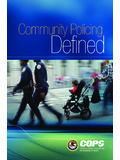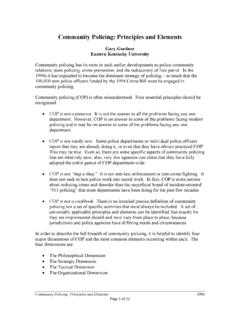Transcription of A NEW POLICING MODEL - New York City
1 Tackling crime, disorder and fear: A NEW POLICING MODEL . The basic mission for which police exist is to prevent crime and disorder as an alternative to the repression of crime and disorder by military force and severity of legal punishment.. Sir Robert Peel's First Principle of Law Enforcement The NYPD in the 1990s: Winning the Battle Against Crime It is widely argued that the United States vi- neighborhoods. Problems, including quality-of-life olent crime wave of the late 1980s and early 1990s problems, were allowed to fester, and by slow de- was a culmination of the general upward trend in grees the police department lost control. Violent crime in the 1960s and 1970s coupled with a spike crime, and especially outdoor violence escalated.
2 In drug-related crime in the 1980s. In New york city , another set of factors also contributed to the crime wave by steering police into a more reactive mode and undercutting their ability to prevent In the late 1980s, the crack epidemic in in- crime. The advent of the 911 system in the late ner city neighborhoods drove violent crime to re- 1960s had the perverse effect of reducing police cord high levels as drug gangs battled over street presence on the street, as officers chased calls for turf and prime drug dealing locations. Homicide service as a first priority. This condition was com- in New york city increased from 1,392 in 1985. pounded by the 1975 Fiscal Crisis and the police to 2,262 in 1990, with 60 percent of the homi- layoffs of the late 1970s, which shrank the avail- cides taking place outdoors.
3 Violent crime the able patrol force. NYPD uniformed personnel measure of murder, rape, robbery, and felony as- fell from a peak of more than 31,000 in the early sault also hit a peak in 1990 of nearly 150,000. 1970s to about 22,600 in 1980, and did not reach incidents. By 1993 there were more than 5,200. 30,000 again until 1994, with the Dinkins Admin- incidents, approximately 100 per week, in which istration Safe city /Safe Streets hiring of the early people were shot in New york city , frequently on 1990s. the streets. Homicide in New york city increased from 1,392 in 1985 to 2,262 in 1990, with 60 percent THE NYPD RESPONDS. of the homicides taking place outdoors.
4 Violent The public demand for the NYPD to tack- crime the amalgam of murder, rape, robbery, le crime in New york city led to the election of Mayor Rudolph Giuliani in 1993 and the appoint- and felony assault also hit a peak in 1990 of ment of William Bratton as Police Commissioner nearly 150,000 incidents. in January 1994. Commissioner Bratton's first or- der of business was to challenge the firmly estab- lished belief that police could only affect crime at The Knapp Commission police corruption the margins and would not be able to drive down scandals in 1970 were also a factor in reducing any city 's crime rates significantly. The Commis- police initiative and presence on the streets.
5 Fol- sioner publicly announced that the Department lowing the scandals, and for many years thereaf- would seek to reduce crime by 10 percent in his ter, patrol officers were actively discouraged from first year. He was confident that key changes in enforcing against such quality-of-life offenses as operations and strategy could push down crime street-level drug dealing, gambling, and prostitu- dramatically. tion because it was feared that such enforcement might open opportunities for police corruption. The combination of all these factors caused what can be characterized as the de- POLICING of many The first, and most important, of these chang- neighborhoods and especially poor and minority es was the development of a command account- TACKLING CRIME, DISORDER AND FEAR: A NEW POLICING MODEL 1.
6 Ability system that came to be known as Com- minor crimes. In 1994, the NYPD embraced pStat. Commissioner Bratton appointed Jack quality-of-life POLICING , enforcing a variety of laws Maple, a former Transit Police lieutenant and against street drug dealing, public drinking, pub- one the great innovators in the history of Amer- lic marijuana smoking, open-air prostitution, and ican POLICING , to be the Deputy Commissioner for other minor offenses, reversing the de- POLICING Crime Control Strategies. Deputy Commissioner trends of the 1970s and 1980s. From 1993 to Maple, working with then-Chief of Patrol Louis 1996, drug arrests and misdemeanor arrests in- Anemone, developed the CompStat system to refo- creased by 98 percent and 51 percent respectively.
7 Cus the police department on its central missions of controlling crime and disorder. The heart of the The CompStat meetings assessed crime system was the semi-weekly CompStat meeting that convened precinct commanders, detective control tactics, held precinct commanders squad leaders, and specialty unit supervisors for accountable for their performance, and lent a intensive crime strategy sessions. Supported by the most recent crime data and by crime mapping pressing sense of urgency to the core business that helped identify patterns, the CompStat meet- of POLICING . ings assessed crime control tactics, held precinct commanders accountable for their performance, and lent a pressing sense of urgency to the core The Department reclaimed many of the city 's business of POLICING .
8 Street corners from drug dealers and other violent criminals who had turned some neighborhoods into shooting galleries. Quality-of-life enforcement Commissioner Bratton's first order of busi- stemmed incipient criminal activity and defused ness was to challenge the firmly established criminogenic environments. Instead of street cor- ners growing more violent as the night wore on, belief that police could only affect crime at the police intervention checked the situation early by margins and would not be able to drive down breaking up the groups who were drinking and smoking marijuana. In the first several years, any city 's crime rates significantly. The Commis- the police were also finding a significant number sioner publicly announced that the Department of illegal firearms on people searched after being arrested for lesser crimes.
9 Would seek to reduce crime by 10 percent in his first year. In 1994, the NYPD embraced quality-of-life po- licing, enforcing a variety of laws against street In a department that had traditionally run on three separate sets of tracks patrol, detectives drug dealing, public drinking, public marijuana and narcotics CompStat became the central fo- smoking, open-air prostitution, and other minor rum for coordinating resources from the various operational bureaus. It also became the showcase offenses, reversing the de- POLICING trends of the of new and effective tactics that spread quick- 1970s and 1980s.. ly throughout the Department. CompStat was particularly effective in countering the pattern crimes of robbery and burglary, usually commit- THE GREAT CRIME DECLINE.
10 Ted by repeat criminals who operate in identifi- able patterns, because the CompStat forum was identifying patterns more swiftly and prompting The shooting numbers plummeted from 5,269. an equally swift police response. The use of timely in 1993 to 3,265 by 1995 to 1,759 by 1998. With the information to identify problems, devise possible decline in shootings came a spectacular decline in solutions, and evaluate the impact of those solu- homicide, with the city recording the four largest tions in so rigorous a forum was a significantdrops in homicide in its history in four successive POLICING innovation that helped focus the enforce-years, including a 345 incident drop in 1994 and ment assets of the NYPD as never before.
















